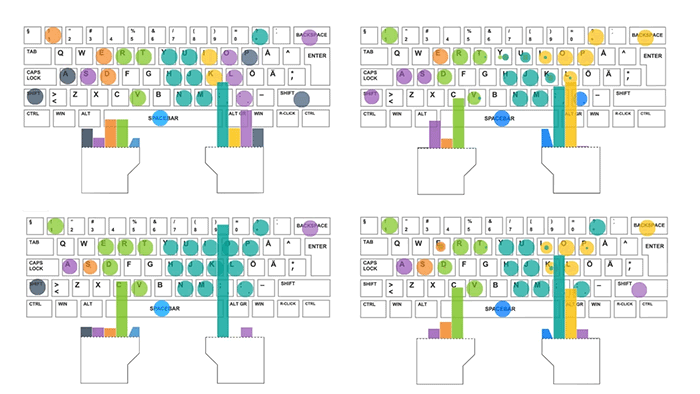The number of fingers does not affect typing speed

Many people think that the ten-finger typing method is faster than others. This point of view is promoted both in typewriting courses and by developers of programs for learning speed dialing. But no one has ever studied what printed strategies exist and how to actually type the text most quickly.
Specialists from Aalto University (Finland) conducted such a study - and found out the amazing fact. It turns out that the speed of typing does not depend on the number of fingers that are used in printing. Self-educated people can type the text with a few fingers on each hand as quickly as the “professionals” using the ten-finger blind method.
As part of the experiment, small reflective markers were attached to the experimental fingers, the position of which was fixed by 12 high-speed infrared cameras (the same high-precision systems are used for filmmaking). In addition, the direction of gaze was tracked using glasses.
')

The experiment involved 30 volunteers of different ages and experiences.
“We were very surprised that people who graduated from print courses showed the same average speed and accuracy as self-taught people who use, on average, six fingers,” says doctoral student Anna Feit.
Dr. Daryl Weir (Daryl Weir) adds that simply information about keystrokes and knowledge of what fingers a person uses is not enough for a thorough analysis. The system of markers with video cameras made it possible for the first time to determine with which finger a person presses each key, and the sequence of such pressing and hand movements (printed strategy).
The video found out several factors that correspond to faster typing: this is the minimum movement of the hands over the keyboard and the tendency to use the same fingers for typing the same letters.
Interestingly, most of the test subjects used their left and right hands in different ways. While the left hand remained almost immobile, the right hand moved much more actively and covered a large number of letters. The diagram shows that the index finger of the right hand of a fast self-taught typesetter covers almost half of the keys. The speed of his typing is the same as that of an experienced stenographer by the blind ten-finger method.

In general, the analysis revealed four user groups that demonstrate similar statistics on the use of the fingers of the left hand, and six groups of users with similar patterns for the right hand.

Self-taught print strategies vary, but they usually use one or two fingers on each hand. Found unique patterns, such as using CapsLock instead of Shift or pressing the spacebar with two thumbs.
But in each group of subjects, no matter how many fingers they used, there were people with low typing speed and high speed. The average speed of dialing does not depend on the number of fingers that are involved in the work.
Nevertheless, researchers note that non-professional users, that is, those who have not completed the blind typing courses, look at the screen less time, and more time at the keyboard. Theoretically, this may affect the speed of performing complex tasks with text editing.
Source: https://habr.com/ru/post/390261/
All Articles